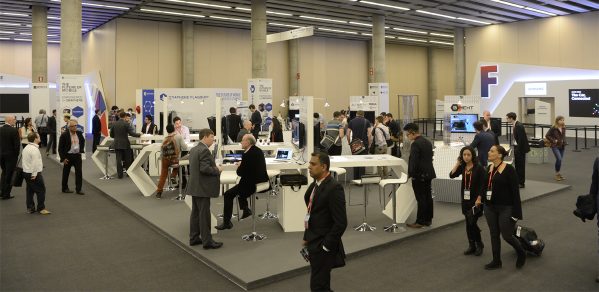
The Cambridge Graphene Centre, together with several of its industrial and academic partners – such as Cambridge-based Nokia, Aixtron, Novalia and Flexenable – have unveiled the inaugural Graphene Pavilion at the 2016 Mobile World Congress (MWC), the world’s largest gathering for the mobile industry with more than 100,000 attendees and 2000 exhibitors. The Graphene Pavilion is a unique space to explore the latest graphene based innovations with numerous prototypes and demonstrations.
Graphene and related materials have started the journey taking them from the labs to the factory floor.
Andrea Ferrari
The Mobile World Congress is an annual event bringing together the brightest minds in the mobile industry and related fields. This year, graphene will be prominently featured within the conference programme with a session dedicated entirely to graphene and its applications.
‘The Graphene Revolution’, taking place 25 February, showcases companies that currently work with graphene, demonstrating new products and capabilities in mobile technology that the material is supporting, using its unique characteristics of strength and electronic support.
Speakers at the session include Professor Andrea Ferrari, Director of the Cambridge Graphene Centre and of the EPSRC Centre for Doctoral Training in Graphene Technology, as well as Chair of the Executive Board of the Graphene Flagship and Leader of the Optoelectronics Work-package. It will also feature talks from industrial and academic partners of the Cambridge Graphene Centre, such as Dr Tapani Ryhänen from Nokia, Professor Frank Koppens from the Institute of Photonic Sciences and curator of the Pavillion, Dr Mike Banach from FlexEnable and Dr Vittorio Pellegrini from IIT.
 “We are thrilled by the opportunity to showcase the progress of the Cambridge Graphene Centre and of the Graphene Flagship at the World Mobile Congress,” Professor Ferrari said. “Graphene and related materials have started the journey taking them from the labs to the factory floor. Consumer electronics and the internet of things are ideal test beds to exploit the new functionalities offered by the even increasing number of layered materials.”
“We are thrilled by the opportunity to showcase the progress of the Cambridge Graphene Centre and of the Graphene Flagship at the World Mobile Congress,” Professor Ferrari said. “Graphene and related materials have started the journey taking them from the labs to the factory floor. Consumer electronics and the internet of things are ideal test beds to exploit the new functionalities offered by the even increasing number of layered materials.”
The Graphene Pavilion includes live demos and prototypes of many different properties and applications such as printable touch sensors (by the Cambridge Graphene Centre and partner Novalia), flexible displays (by the Cambridge Graphene Centreand FlexEnable) and a number of different flexible near-field communication antennas, sensors and ultra-fast photo receivers (also produced in collaboration with the Cambridge Graphene Centre). Dr Stephen Hodge and Dr Nicolas Decorde will present several of the demos and interact with visitors and media throughout the week.

